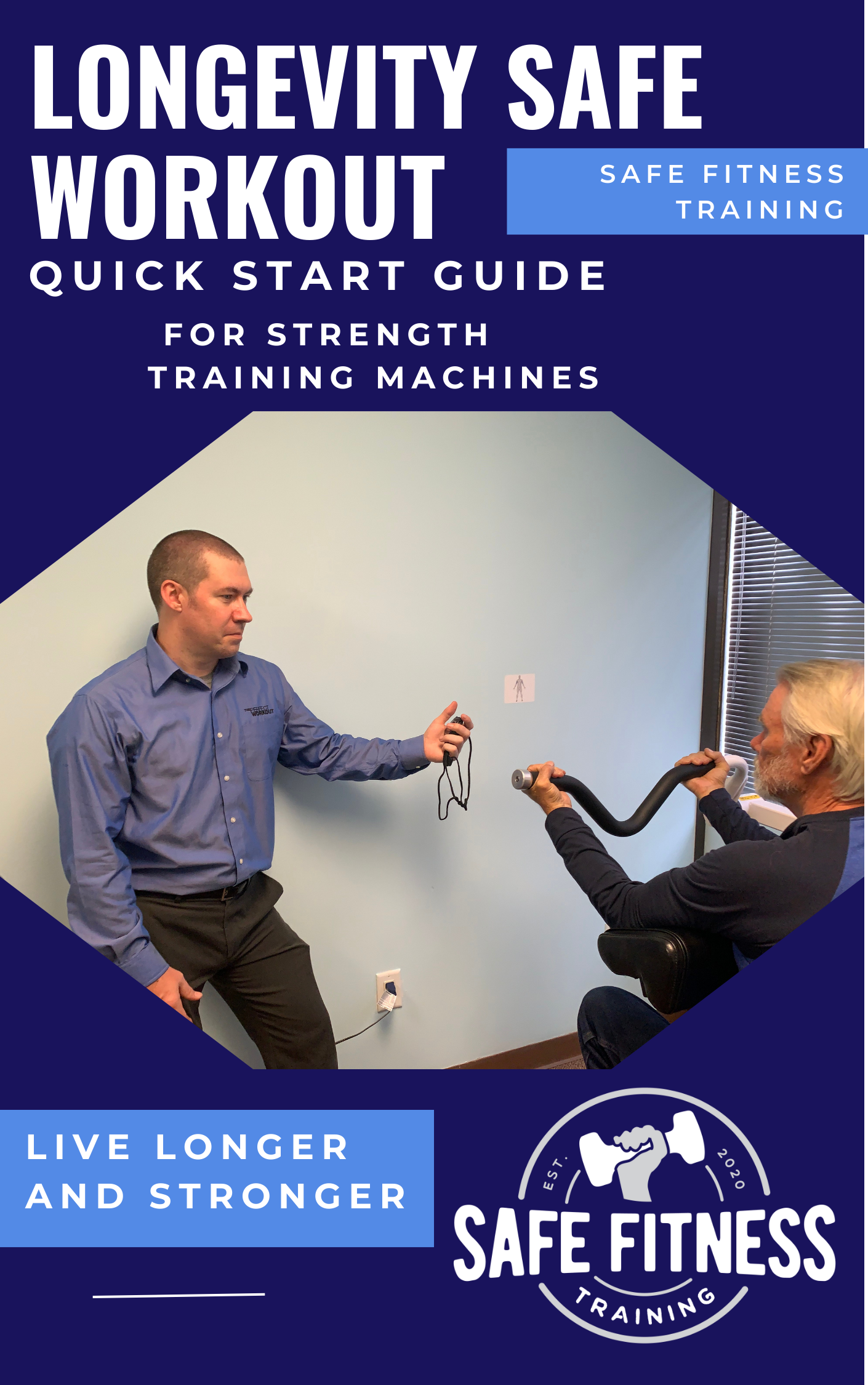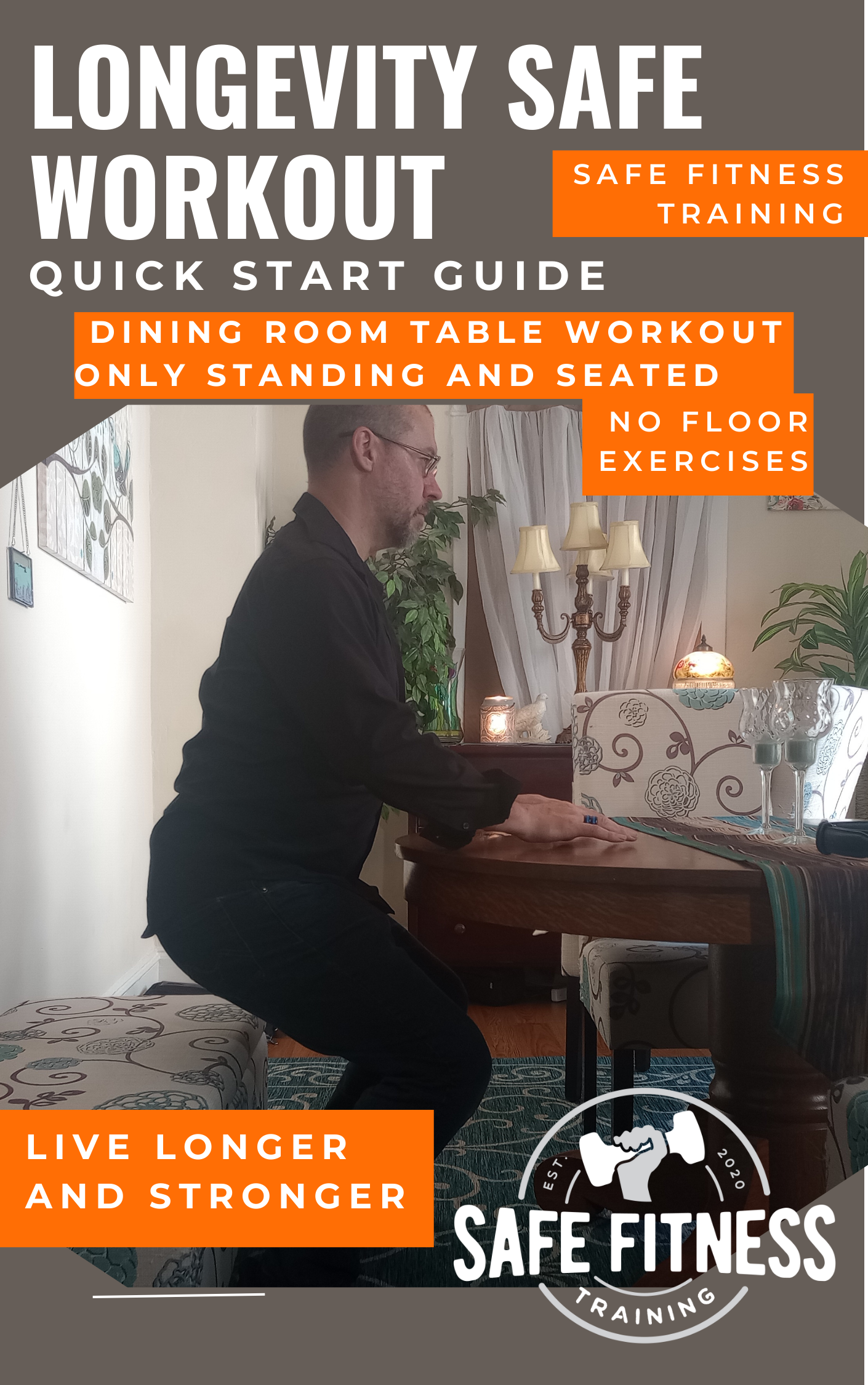Get my Free Quick Start Guide PDF and Get Started with a full video course Safe Strength Training on Gym Machines!
Free PDF Guides for At Home Exercise - Floor Exercise OR Seated and Standing Exercise! Or a video course for AT HOME Exercise!
Benefits of Strength Training
There are SO many benefits of strength training. When strength training exercises are performed safely and properly, people of ALL age groups gain these benefits. My youngest client to use this method was 17 while my oldest current client is 93 years old. The full body workout routine I use for my clients is best suited for use on nautilus machines (or other low friction machines) to get the absolute best results and safety. Lets talk about the benefits:
Benefits of Strength Training #1:
Build Muscle and Maintain Muscle
(reverse sarcopenia)
Like I've mentioned before, sarcopenia is the loss of muscle mass over time. After around the age of 26 people on average will lose 5-7 pounds of muscle every ten years (Forbes 1976, Evans and Rosenberg 1992). Even though activities like jogging or biking will help circulate blood flow and promote cardiovascular health, but you don't get strength training benefits, you'll continue to lose muscle at the same rate without working the muscles. Read even more about the science and importance of strength training here.
Most individuals have lost so much muscle mass over time from not activating their muscles with weight training, but the good news is that two short sessions twice a week can add an average of three pounds of muscle in about two months of training. (Westcott and Guy 1996). This is exactly why I work with my clients on weight training exclusively. The benefits of strength training long term are so much greater than anything else I've tried as a fitness trainer. Here are some of the important strength training principles and guidelines
Strength Training Benefits #2
Lose Fat by Increasing Resting
Metabolism

When people talk about how their metabolism has slowed down in their older age they are basically saying that they've lost muscle mass, even if they don't know that's what they're saying. Without building muscle through strength training our metabolisms slow up to 5% every ten years (Evans and Rosenberg, 1992).
But there is hope, of course :), one of the benefits of strength training is that with every ONE pound of muscle we add to our bodies we are able to increase metabolism to burn an extra 37.5 calories per day, and that's just at a resting state! (Darden, Flat Abs Now) Think about how beneficial that would be long term, adding nine pounds of muscle to your body. It would burn more calories than running four miles every day!
Benefits of Strength Training #3
Decrease Resting Blood Pressure
One of the more well known benefits of strength training is that it generally reduces resting blood pressure (Harris and Holly 1987). I have seen clients step down their dosage of blood pressure medication from incorporating strength training into their weekly routine. As we get older this becomes more and more important. My Dad is one of my fitness clients and his blood pressure has been regulated since we began working together, I'm very grateful for his ongoing results.
Strength Training Benefits #4
Lessen Lower Back Pain
Since 80% of Americans have lower back problems it's important to put at least some focus into strengthening the lower back. I use a few machines and various isometric exercises to really get in deeper to strengthen these muscles (erector spinea). One of my clients had been struggling with lower back pain for years and this has eliminated his need for medication to regulate it. I'll go into further detail and show examples in videos of the exercises that focus specifically on the strength training benefits and how to work the lower back muscles.
Benefits of Strength Training #5
Lessen Osteoarthritis Pain in
Joints
Over time our joints wear and tend to break down. I haven't been the nicest to my joints over the years, putting a lot of unnecessary stress on them with the martial arts training I've maintained even into my older age. The strength training benefits I felt within the very first few months brought my knee pain down by a LOT. One study of people aged 55 and older showed that on average arthritic knees have been strengthened by 71% and the pain from arthritis decreased by 41% by using strength training.(Baker and Nelson 2001).
Strength Training Benefits #6
Depression Reduction
One of the most unexpected benefits of strength training was sited in a Harvard University study. After 10 weeks of strength training in seniors 87% of the individuals no longer fit the bill of being “clinically depressed”. (Singh 1997) As unexpected as it would be, it makes a lot of sense to me, many clients have repeatedly told me how much their overall mood and their mental and emotional well being has changed for the positive.
These are only some of the changes that have been documented in studies as verified with clinical studies. More and more research continues to show the benefits of strength training. I continue to see visible changes in my client's lives and it's inspiring to see and experience for myself. I'd love to see YOU have these same benefits and experiences. THAT is why I am here, hopefully you begin a strength training program after seeing how much it can impact your health, fitness, and well being.
In the last few paragraphs of this page about the definition of exercise and strength training Ken Hutchins bravely redefines what exercise is and creates a fitness revolution that continues to shape the fitness community. A redefinition IS in order with so many incorrect assumptions floating around within fitness, let's look to the SCIENCE of the matter.
-J.G.
References:
Campbell, W.,Crim, M., Young,V. and Evans,W. (1994). Increased energy requirements and changes in body composition with resistance training in older adults. American Journal of Clinical Nutrition, 60: 167-175.
Evans, W. and Rosenberg, I. (1992) Biomarkers, New York: Simon and Schuster. Forbes, G. B. (1976). “The adult decline in lean body mass,” Human Biology, 48: 161-73.
Harris, K. and Holly R. (1987). Physiological response to circuit weight training in borderline hypertensive subjects. Medicine and Science in Sports and Exercise, 19: 246-252.
Hurley, B. (1994). Does strength training improve health status? Strength and Conditioning Journal, 16: 7-13.
Hurley, B., Hagberg, J., Goldberg, A., et al. (1988). Resistance training can reduce coronary risk factors without altering VO 2 max or percent body fat. Medicine and Science in Sports and Exercise, 20: 150-154.
Keyes, A., Taylor, H.L. and Grande, F. (1973). “Basal Metabolism and Age of Adult Man,” Metabolism, 22: 579-87.
Koffler, K., Menkes, A. Redmond, W. et al. (1992). Strength training accelerates gastrointestinal transit in middle-aged and older men. Medicine and Science in Sports and Exercise, 24: 415-419.
Menkes, A., Mazel, S., Redmond, R. et al. (1993). Strength training increases regional bone mineral density and bone remodeling in middle-aged and older men. Journal of Applied Physiology, 74: 2478-2484.
Risch, S., Nowell, N. Pollock, M., et al. (1993). Lumbar strengthening in chronic low back pain patients. Spine, 18: 232-238.
Singh, N., Clements, K. and Fiatarone, M. A randomized controlled trial of progressive resistance training in depressed elders. Journal of Gerontology, 52 A (1): M 27 - M 35.
Stone, M., Blessing, D., Byrd, R., et al. (1982). Physiological effects of a short term resistive training program on middle-aged untrained men. National Strength and Conditioning Association Journal, 4: 16-20.
Tufts University Diet and Nutrition Letter, (1994). Never too late to build up your muscle. 12: 6-7 (September).
Westcott, W. and Guy, J. (1996). A physical evolution. Sedentary adults see marked improvements in as little as two days a week. IDEA Today, 14 (9): 58-65.



